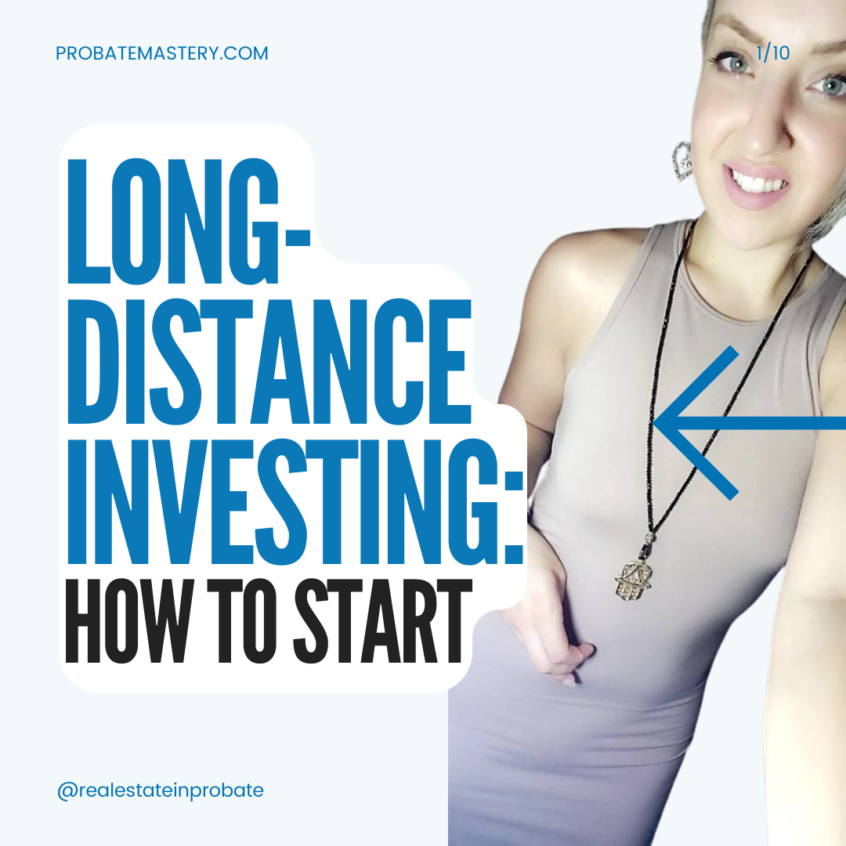What is long-distance real estate investing, and why should you care?
Long-distance real estate investing, also called remote investing or virtual investing, is a simple concept. It simply means that real estate investing is done remotely, entirely online. And because it can be done online, real estate investors are able to invest long-distances, out of state, without ever having to set foot on the property they’re purchasing (or assigning, if your goal is virtual wholesaling!).
Compared to traditional investing, virtual real estate investing is a relatively new strategy. The market for long-distance investment properties is growing as more investors realize how lucrative it can be. This type of real estate investing strategy is ideal for anyone who lives outside a targeted area—for example, an investor living in Seattle but looking to buy virtual real estate in Phoenix.
With low-interest rates and the work-from-home boom, the demand for housing has surged in many areas across the country. Investing in virtual real estate allows investors to take advantage of high demand without having to be physically present at any property they buy. Long-distance investments ideally are located in areas where jobs are growing, and thus residents are creating a growing demand for housing.
Is remote real estate investing right for you?
Remote real estate investing is ideal for investors that are comfortable using real estate investment software to research and analyze potential real estate deals. Investors seeking to work remotely should also be comfortable using technology that can facilitate remote transactions.
Virtual real estate investing is also perfect for investors who are looking to buy rental houses or commercial property but don’t have time to manage the properties on a day-to-day basis.
Where long-distance real estate investing works best:
Long-distance real estate investing typically works in metropolitan areas where a larger number of people are looking to buy homes.
Virtual real estate investing is particularly viable in growing neighborhoods, near universities or technical schools, and virtual commercial properties can do very well in thriving business districts.
Virtual real estate investments aren’t as viable in remote areas or small towns with little demand from residents, though some rural locations are really great long-distance rental opportunities as long as there is matching demand and end-use—for example, short-term rentals near a major tourist attraction.
What virtual real estate investing costs:
Virtual real estate investments typically only require the initial purchase cost of the virtual properties, which can be as little as 5 percent to 20 percent of market value or purchased through creative finance strategies.
If you prefer to purchase leads and software, such as a CRM, the costs of the specific products must be considered as well.
If you will be hiring a property manager to fill and maintain your long-distance rentals, expect to pay about 2 percent to 5 percent in property management fees.
Benefits of remote real estate investing compared to traditional, in-person investments
- Virtual real estate investing is a much more accessible type of investment. You don’t need to travel long-distance, meet with other people face-to-face during social distance protocols, and plan around showing times.
- Real estate investors looking to invest virtually can research deals and make purchases anywhere they have an internet connection.
- Because of its accessibility, virtual estate investing requires less time and effort when compared to traditional, in-person investments.
- Long-distance investing provides new ways for people to make money through real estate investing when their local market conditions aren’t ideal.
- Long-distance investing can help real estate investors diversify their portfolios.
- Living long-distance almost necessitates automation and outsourcing. Real estate investors often get bogged down handling handyman and maintenance tasks, even when it would make sense to outsource. The long-distance aspect helps inspire that leap of faith towards hiring boots on the ground and reclaiming your time.
Remote investing with commercial properties
Commercial real estate investing is also entirely possible to do long-distance. Some websites specialize in matching commercial properties to virtual investors, which can expand the potential opportunities for virtual commercial property owners.
Virtual commercial real estate investing is also for warehouses, industrial buildings, mixed-use properties, office space, retail buildings, multi-family units, and more.
Retail storefronts or office buildings are well-suited for virtual investors because they require little upkeep and can be purchased occupied.
Vacant commercial properties can also do very well in growing neighborhoods with increasing populations and lots of foot traffic.
The best commercial property investments for long-distance investors are investments in areas where demand is increasing and expected to remain high.
Tips for getting started with long-distance investing:








- Find a real estate agent in your target market. Seek out an agent that has their own team. This is a great indication they’re savvy enough to scale and grow their business and have also built strong relationships with quality vendors in the local area. They’ll know who you need when it comes time for maintenance, marketing, and any unexpected problems! Your real estate professional should be able to provide you with insights on local market trends and specific neighborhoods.
- Learn the different neighborhoods. If you’ll be buying properties to hold and sell in the future, desirability is an important factor when determining buy and hold potential. When investing long-distance, you might not know the neighborhoods in your target market the same way you know the neighborhoods around where you live. And while you can grab things like walk scores from websites like Zillow, you need a little bit more insight. Find REIA groups and real estate professionals in that area to follow on social media and stay in the loop on market insights. Another great idea is to search “living in ___________” and find YouTube or Tik Tok channels that do video drive-throughs of neighborhoods in that market.
- Get an idea of what property taxes and HOA fees you’ll pay. When you’re looking at properties across city or state lines, it can be hard to keep up with all the tax rules. If you’re looking at residential investments in a new market, it’s also a good idea to speak with local investors and property managers and ask them what’s important to know about HOAs in the area.
- Research homeowner’s insurance rates and benefits. Try not to get too excited if the grass looks greener on the other side! Take time to compare rates and benefit offerings from a few different companies in your target market. It’s also worth looking at renters’ insurance rates and benefits. Environmental factors, landlord-tenant expectations, and related rules, regulations, and fees for insurance policies and claims can vary greatly from state to state.
- Calculate rent ranges. You want to establish a bottom line so that you know how much people and businesses will pay to rent where you’re investing. You’ll also want to have a general idea of the maximum comparable rent rates for a given property type in a specific neighborhood before planning any repairs or upgrades. Knowing the rent range in your prospective virtual market can help you ensure your target acquisitions have appropriate, profitable end-users before committing to purchases, repairs, and upgrades. You can use tools like rentometer.com, browse classifieds like Craigslist, or browse rental listings on sites like Zillow.com. To browse commercial listings, try Loopnet.com and CREXI.com.
- Get a rough idea of vacancy and absorption rates. You’ll want to be able to compare rates between periods of time AND between types of properties. This is a bit easier to do with residential rentals because of the volume and availability of data. A simple way to get a feel for vacancy rates for apartment and single-family rentals is to bookmark a few properties while you’re researching rental rates. Check them periodically to see if they are still available; if all units are going quickly, demand is high and that’s a good sign you won’t have to deal with long vacancy periods if your rent price is set properly. Low vacancy periods can also indicate high neighborhood desirability and suggest this market has positive momentum for growth. Commercial properties take a bit more effort, as property details can vary greatly and there might not be many comparable examples in a short time frame. You’re more likely to have to extrapolate and make inferences when dealing with commercial properties, and your research might need to get more technical. A great starting point is to search for vacancy and absorption rates using a search engine (be sure to include keywords for your target market), and see if any analysts, agencies, or organizations have already done some of the leg work. Here’s an example of how to start such a search:
- Know your price-to-rent ratio and stick to it. The 1-percent rule is a great way to determine if your purchase will be profitable. If the property can generate at least 1% of its overall cost in monthly rent, then you have found an affordable investment that is likely to provide positive cash flow for years to come. Be sure to take into account all of the costs involved, such as purchase price, financing fees, interest, repairs during and between occupancy, and tax and insurance payments. For positive monthly cash flow and the opportunity to sell for a profit down the road, you want to answer two things: Can this property’s cash flow remain positive if the market takes a downturn, turnover rates go up?; and do market trends indicate the value of the property will increase while you hold the property? If the answer to both questions is yes, you’re likely looking at a great long-term investment opportunity.
- Know how to get out before you get in. If there’s anything worse than being too invested, it would be not having a plan for when you’re too invested. Make sure you have an exit strategy before starting on this journey and stick to it! Knowing when to cut losses is critical for risk management.
So yes, you can make money through virtual real estate investing – all from your remote work space!
Real estate investing doesn’t require physical presence. With the right diligence and willingness, long-distance investing can provide an opportunity for building property portfolios while growing wealth through strategic risk management and creative financing strategies.
If you’re ready to dot all those i’s & cross t’s, consider immersing yourself with a community of like-minded individuals: Estate Professionals Mastermind



One Comment on “Long-distance real estate investing: How to get started investing in real estate remotely”
I just got married so I am planning to put my old house up for rental. Thanks for mentioning here that a good property manager would know all the fees and procedures relating to the homeowners’ association. I may experience difficulties in the future, so I’ll be sure to consider these services to gain some more income as well.